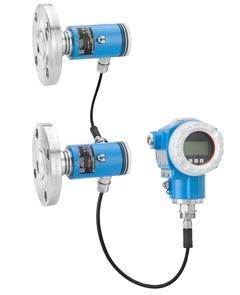The electronic dp Deltabar FMD71 from Endress+Hauser is a differential pressure system that is utilized to quantify the pressure or level, volume or mass of liquids in distillation columns/evaporators or pressurized tanks.
The high-pressure sensor (HP) quantifies the hydrostatic pressure. The low-pressure sensor (LP) assesses the head pressure. The level is estimated in the transmitter with the help of two digital values. The electronic dp system removes problems of conventional differential pressure measurements.

Image Credit: Endress+Hauser Ltd.

Image Credit: Endress+Hauser Ltd.
For differential pressure, volume, level or mass measurement of liquids in distillation columns/evaporators and pressurized tanks.
- Process connections: Threads, flanges and hygienic connections
- Process temperature: −40 up to +150 °C (−40 to +302°F)
- Measuring range: 100 mbar to +40 bar (6 to 600 psi)
- Accuracy: Single sensor up to ±0.05%, system up to ±0.07%
- International explosion safety certificates and hygienic approvals
Extended Selection
- Highly functional and practical
- High-end products

Image Credit: Endress+Hauser Ltd.
Benefits
- Removes traditional mechanical problems leading to higher process availability and reliability
- Availability of overload-resistant high-purity ceramic sensor (99.9% Al2O3)
- With the new electronic differential pressure system architecture and design, safety risks are reduced
- The lowest total cost of ownership as a result of decreased installation time, downtime, maintenance and spare requirements
- Long-term stability and high reproducibility
- Constant health indication of the full system through HART-based diagnostic
- Multivariable level measurement: HART-based differential pressure, head pressure and sensor temperatures from one system
Specs at a Glance
Accuracy
- “PLATINUM” 0.05% of individual sensor
- 0.075% of individual sensor
Process Temperature
- –25 to +150 °C (–13 to +302 °F)
Pressure Measuring Range
- 100 mbar to 40 bar (1.5 psi to 600 psi)
Process Pressure Absolute/Maximum Overpressure Limit
Material Process Membrane
Measuring Cell
- 100 mbar to 40 bar (1.5 psi to 600 psi)
Specifications
Source: Endress+Hauser Ltd.
| . |
. |
| Measuring principle |
Differential pressure |
| Characteristic / Application |
Electronic differential pressure transmitter with ceramic sensor (Ceraphire) for level,
volume or mass measurement in liquids. |
| Supply / Communication |
4...20 mA HART: 12...45 V DC
Exia: 12...30 V DC |
| Accuracy |
0.075% of individual sensor,
"PLATINUM" 0.05% of individual sensor |
| Long term stability |
0.05% of URL/year of individual sensor |
| Ambient temperature |
–40...+80 °C (–40...+176 °F) |
| Process temperature |
–25...+150 °C (–13...+302 °F) |
| Process pressure absolute/max. overpressure limit |
60 bar (900 psi) |
| Pressure measuring range |
100 mbar...40 bar
(1.5 psi...600 psi) |
| Process connection |
Threads
Flanges (DIN, ASME, JIS) |
| Process connection hygienic |
DIN11851
DIN11864-1
Tri-Clamp
DRD
Varivent |
| Communication |
4...20 mA HART |
| Certificates / Approvals |
ATEX, FM, CSA, CSA C/US, IEC Ex, NEPSI, INMETRO |
| Design approvals |
NACE MR0175
EN10204-3.1 |
| Hygienic approvals |
FDA
3A |
| Options |
4-line digital display
SS- or Aluminium housing |
| Application limits |
Use Software Applicator Sizing Electronic DP |